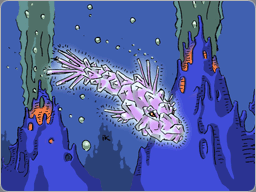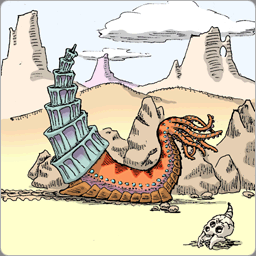
SAIS Galactic Guidebook
Chapter Three: It's Life But Not As We Know It
Waiter, there's life in my soup!
When you're dining out at a nice restaurant, you don't want to see anything burbling or wriggling in your posh soup. It's a fancy place; you just can't have that. You look down at the soup bowl again. You don't see anything. Then a single red eye on a slender green tentacular stalk emerges from the broth and blinks back at you!
Should you call the waiter? Don't embarrass yourself. It's only the primordial soup du jour, and it comes with every entre.
In this ongoing and often-updated chapter of the Galactic Guidebook our goal is to focus on the more fascinating (some would say monstrous) lifeforms which inhabit the myriad planets of Sector Prime. There is an abundance of uncanny life in the Purple Void and no matter which world you visit, from Sheilus to the reefs of Kizmar, you'll find strange living things, electric birds, turtle-bears, nose beasts and worse, slithering, hopping, barking...and just waiting to be discovered. -So, we went out and discovered some. We don't make this stuff up you know.
 Crystal Fish
Crystal Fish
Common Name: Crystal Fish
Scientific Name: Placodermis Krystalla
Size: 30cm
Diet: Minerals; bacteria and other microorganisms
Habitat: Hot springs and sulphur fumaroles
Location: Any planet where volcanic activity is present
Organization: Solitary
Natural Enemies: None
Description: Existing in a tenuous balance between evolution and annihilation, these delicate aquatic creatures inhabit hot springs and sulphur fumaroles.
Senses: A crystal fish can apparently see, but how or what it sees through the two gold metallic orbs it possesses is anyone's guess. Its reactions to other forms of stimuli besides light cannot easily be discerned -with the exception noted below.
Feeding Habits: A filter feeder. A crystal fish literally breathes hot water, which passes into its mouth, through its body and out again, exiting through its gills, which appear to be its spindly crystal fins. Minerals, bacteria and other microorganisms are absorbed into its body in this way, replenishing and sustaining it, if in a very slow manner.
A crystal fish can survive for extremely long periods of time outside of its usual aquatic environment. Water at normal or cold temperatures simply slow the crystal fish's already lethargic metabolism down a notch or two. It can even be frozen and then miraculously revived years later.
Crystal fish are inactive out of water and go brittle and dormant within minutes of leaving their boiling environment. Many crystal fish are displayed in museums in this form, and are highly sought after by art dealers and wealthy collectors.
Reproduction: Crystal fish do not reproduce. They form, so to speak, by a rare, complex and not wholly understood process dependent upon the amount of raw minerals and exotic microorganisms present within a seemingly inhospitable underwater environment.
Life Span: Indefinite
 Snailopus
Snailopus
Common Name: Snailopus
Scientific Name: Cephaloctopi Malleatus
Size: Length 1.5m Height 1.5m
Diet: Animavore
Habitat: Arid deserts and salt flats
Location: Sector Prime desert and temperate worlds
Organization: Solitary
Natural Enemies: Crab Monster
Description: An animavorous man-sized nautilus. When hungry its feeding tentacles emerge from its cone to entangle small creatures. It then absorbs their life force by emitting a weak osmotic field.
Senses: Four. A snailopus can taste and touch (tentacles), hear (vibrations in its cone), and see (sensory nodules along the side of its body) but it cannot smell. A snailopus can apparently also sense anima, life force, within a surprisingly large radius. (50m or more.)
Feeding Habits: A snailopus is anything but quick. It may take several minutes for it to get close enough to attack its prey. It does so by slowly extending its feeding tentacles towards an injured or sleeping lifeform while undulating them slowly and provocatively.
Upon contact, however, a snailopus's pseudopods begin to flail wildly, quickly confusing and entangling the unfortunate victim. It then emits a visible osmotic nimbus (perhaps from the gemlike nodule located deep within its rubbery body) which drains the creature's life essences, leaving a lifeless carcass behind.
Reproduction: Every other year, the tip of a snailopus's shell cone breaks off. Within is a tiny snailopus infant already thirsty for life.
Life Span: 10 - 20 years